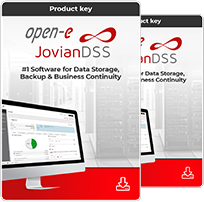The Failover feature provides High Availability of data. In an iSCSI Failover setup of two servers, data is saved on both servers simultaneously. When one system fails , its processes and all resources are being relocated to and restarted on the second node. The Active-Passive setup allows having all volumes active on one node (the primary node), while the other node has all passive copies and takes over the tasks in case of an emergency (the secondary node). A load-balanced Active-Active Failover on the other hand, doesn’t have a primary or secondary node. It adds extra performance by enabling the user to decide which volumes are active on which node. The failover process is the same, but the servers are able to utilize their full network performance and eliminate the unnecessary cost of idle hardware.
Key uses for Failover:
- Highly available SAN (Storage Area Network) storage systems
- High Availability and performance back-end storage for virtualization, databases and more
Benefits of Failover in Open-E software
iSCSI protocol – iSCSI (Internet Small Computer Systems Interface) is a storage area network (SAN) protocol, allowing organizations to consolidate storage into data center storage arrays while providing hosts with the illusion of locally attached disks. iSCSI works by transporting block-level data between an iSCSI initiator on a server and an iSCSI target on a storage device. The iSCSI protocol encapsulates SCSI commands and assembles the data in packets for the TCP/IP layer. In short, iSCSI allows two hosts to negotiate and then exchange SCSI commands using Internet Protocol (IP) networks.
Doubled performance – Both Active-Passive and Active-Active load balanced failovers create a high available storage cluster. The difference between them is the option to utilize all hardware and to increase performance by a factor 2 or more. In an Active-Passive setup, the primary server is under 3 times as much load as the passive node and can slow down the total performance of the cluster if there is a high amount of load. By balancing the load on both nodes, both work at their full potential increasing the performance, system life and return-on-investment.
High Availability – Not a privilege, but a necessity. An organization’s capability to continue delivering their products or services during disruptive incidents is crucial. 40% of service interruptions are caused by power station failures, 25% are hardware failures, and 13% are software failures, such as miss-configuration or severe bugs. What downtime mostly stands for are costs. But with Open-E’s failover technology and professional partner support, organizations are able to continue their business operations with 99.999% data availability.
Metro Cluster – Decentralized data protection. A metro cluster is a general term describing a cluster that consists of several independent nodes that work in unison. A metro cluster allows the nodes to be placed in completely different locations, i.e. the company’s primary and secondary sites, or in different fire areas of the same building. The Metro Cluster double-functions as a disaster recovery plan and as High Availability cluster, at the same time providing additional value without extra costs.
